- Things to do in Hanoi Old Quarter
- Hanoi City Motorbike Tour
- Hanoi Trendy Hotel & Spa, Vietnam
Hanoi City Motorbike Tour
Quick Links
On this page:
> Motorbike City Tours
> The 'Hanoi City Insight' Motorbike Tour
> First stop - A Traditional Vietnamese Lunch!
> Banana Island
> Long Biên Bridge
> Hanoi French Quarter
> Hanoi Old Quarter
> Ba Dinh Square / Ho Chi Minh Mausoleum
> Huu Tiep Lake, A downed B-52 Bomber & Tea with a Local
> West Lake & The Tran Quoc Pagoda
> The Ride Home
> Gallery & Video
> My View of Hanoi Motorbike City Tours
Exploring Hanoi and the Old Quarter by foot might be a great way to get up close to life in the capital, but you can only cover so much ground. A more comfortable (and fun!) way to experience the labyrinth of alleyways and back streets in the city, and to reach further afield too, is to choose a Hanoi motorbike tour.
Several motorbike tour companies operate in the city. A quick Google search and browse of the reviews will help you in your choice. I decided on Motorbike City Tours, a company operating in Hanoi since 2016, “combining Vietnamese motorbike culture with tours that capture the hidden parts of each city” (they operate in Hue too).
Skip the blurb and view my 60-second Hanoi Motorbike Tour videos here
Motorbike City Tours
Motorbike City Tours is an all-female driver company based in Hoan Kiem District, Hanoi. The company employs Vietnamese women only, offering them a work opportunity in a country where women still face numerous barriers to employment.
All drivers are licensed with several years experience of riding motorbikes. They’re further trained by specialists from the Vietnam National Traffic Safety Committee. The company then selects only the best drivers to ensure customer safety. It’s good to know then that you’re in safe hands.
But beyond their motorcycle prowess, the drivers are chosen for their passion, enthusiasm and knowledge of Vietnamese culture and tradition. Keen to share their knowledge, many have studied tourism at university.
The tours: The company offers a variety of guided journeys; from city tours to countryside trips, sunrise and sunset tours, as well as a nighttime foodie tour. You can find out more on motorbikecitytours.com.
The ‘Hanoi City Insight’ Motorbike Tour
I decided on the Hanoi City Insight Motorbike Tour. There’s a morning tour from 8:00am – 12:30pm or afternoon tour from 1:00pm – 5:30pm. I chose the latter. Lunch and a hotel pick-up/drop-off are included in both.
Map of highlights of the Hanoi City Insight Motorbike Tour
I was met at my Old Quarter hotel by Lauren who would be my driver and guide for the day. Elegantly dressed in an orange traditional Vietnamese Ao Dai, Lauren took me through the preliminaries for the day and introduced me to our transport …a shiny deep-red automatic Honda Lead scooter… apparently the most environmentally friendly motorbike in Vietnam!

But not only is it friendly to the environment, the bike is friendly to your derriere too! The wide seat provides plenty of storage for your backpack etc but is also extremely comfortable. And with the added back-rest, it would turn out to be the most comfortable ride I’ve ever had on the back of a scooter (and I’ve been on a few!).
First stop – a Traditional Vietnamese Lunch!
After a short ride through Hanoi’s busy lunchtime traffic, we stopped for lunch for some traditional Vietnamese food. Already in the restaurant were several other of the tour company’s drivers and their customers who were either about to begin their journey, like me, or who had just finished their morning tour. All the drivers were similarly dressed in the company’s elegant orange Ao Dai and seemed a very friendly bunch.
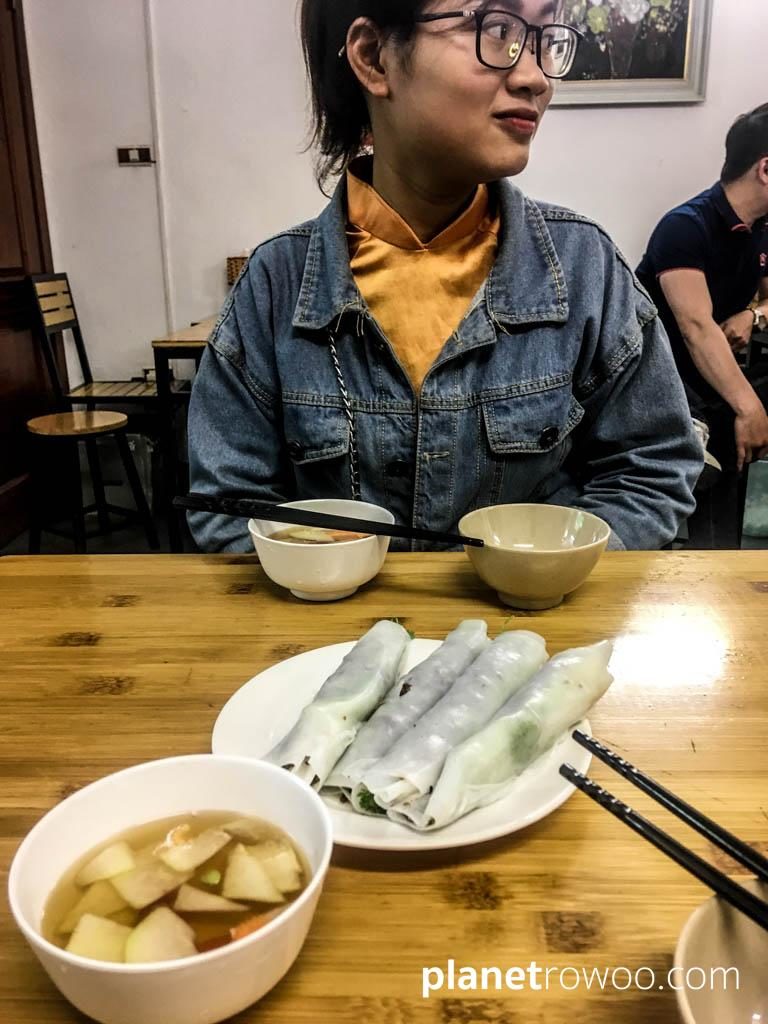
As we sat and ate our excellent Gỏi Cuốn (fresh spring rolls in rice paper) and Bún Bò Nam Bộ (beef noodles) we chatted. Lauren’s English was excellent. She was as interested in finding out about me and my home country of England as I was in learning about her and Hanoi. Thankfully however, once the conversation turned to ‘Brexit’, it was time to move on and start the tour proper.
Banana Island
From the restaurant, we negotiated more of Hanoi’s meandering back streets. These soon transformed into a rural dirt track, crossing over a small rickety metal bridge. The rows of narrow fronted tunnel houses of the Old Quarter were now replaced by a canopy of guava and banana trees.
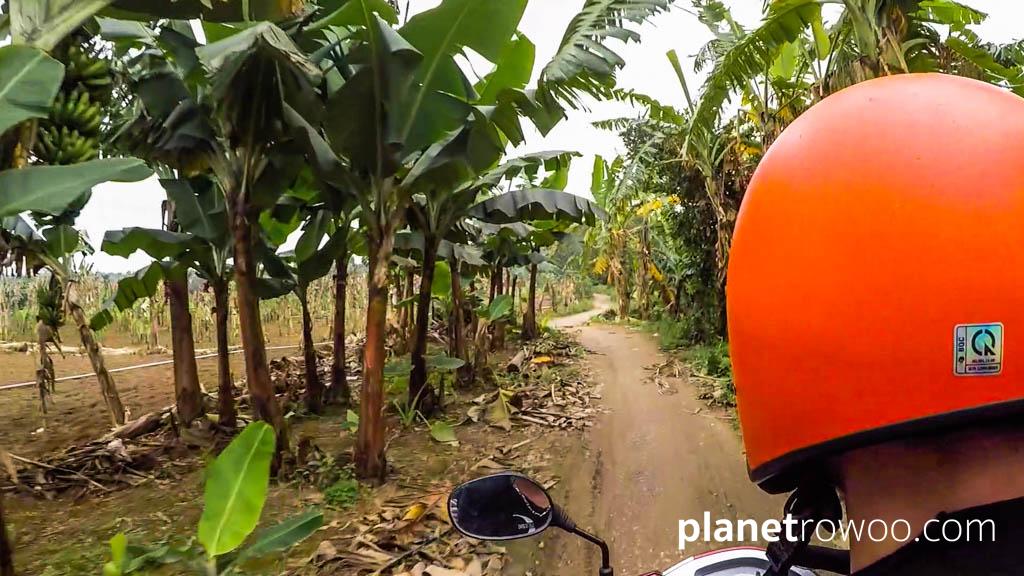
Banana Island, or Bãi Giữa (Middle Island) as it’s known to the locals, is a stretch of agricultural land in the middle of the Red River. During the flood season, from early June to late July the island is submerged in water. But for the rest of the year, the land is farmed by a small community. Banana plantations dominate the island, but other crops including maize and vegetables are also grown.
Banana Island was quite a surprise to me. It’s not widely written about. In fact, I wasn’t aware of its existence before I took this motorbike tour. But it’s a wonderful contrast to the hustle and bustle of the chaotic city. A quiet and peaceful reprieve from the beeping horns of Hanoi’s crowded streets, where you can surround yourself with nature. It’s definitely worth a detour.
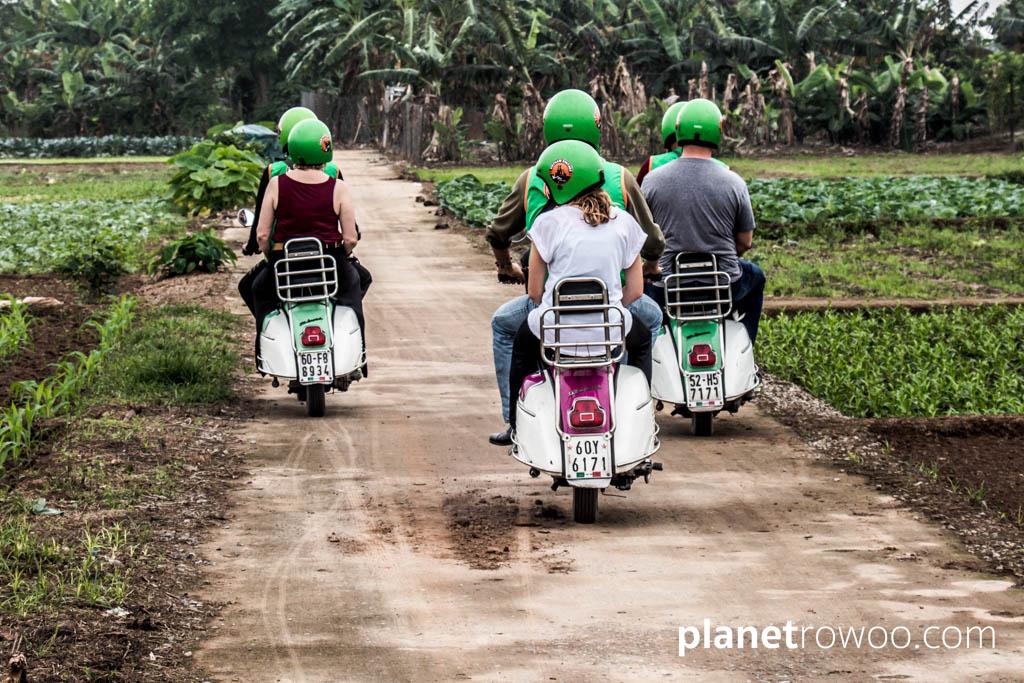
We must have entered somewhere at the north of the island. As we wound our way down through farmlands and green gardens that stretched in all directions, the iconic form of the 100-year-old Long Biên Bridge loomed into view at the southern end of the island. Its rusting iron structure was a stark contrast to the green and natural surroundings.
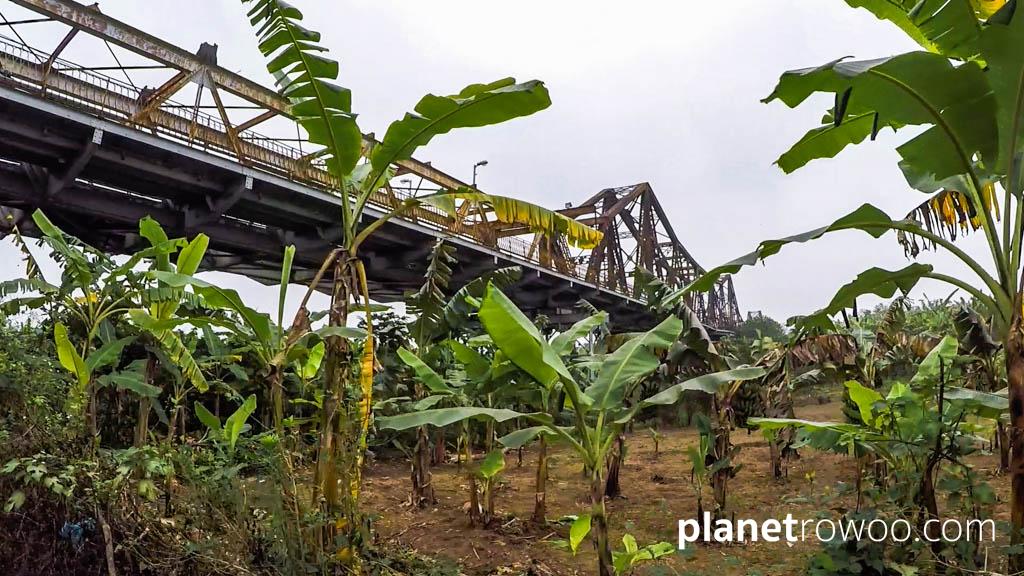
Long Biên Bridge
The Long Biên Railway Bridge (Cầu Long Biên) stretches for 1.7km across Hanoi’s Red River, connecting the Hoan Kiem and Long Bien districts of the city. Built in French colonial times over 100 years ago, the bridge was bombed several times during the American war (it played a strategic role during the war, connecting Hanoi with military supplies from the Soviet Union and China). Today, this iconic structure still bears the scars of wartime and has become a symbol of the resilience of the Hanoi people.
It’s still an active bridge with dozens of trains crossing it every day. A narrow road and pathway on each side of the tracks allows for motorbike, bicycle and pedestrian traffic too.
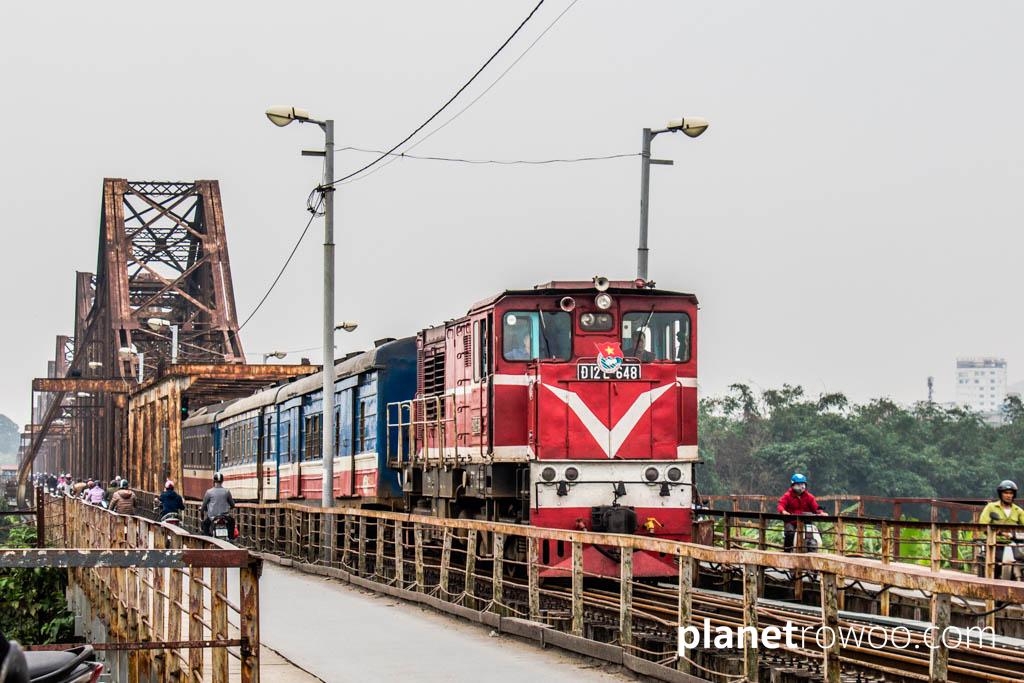
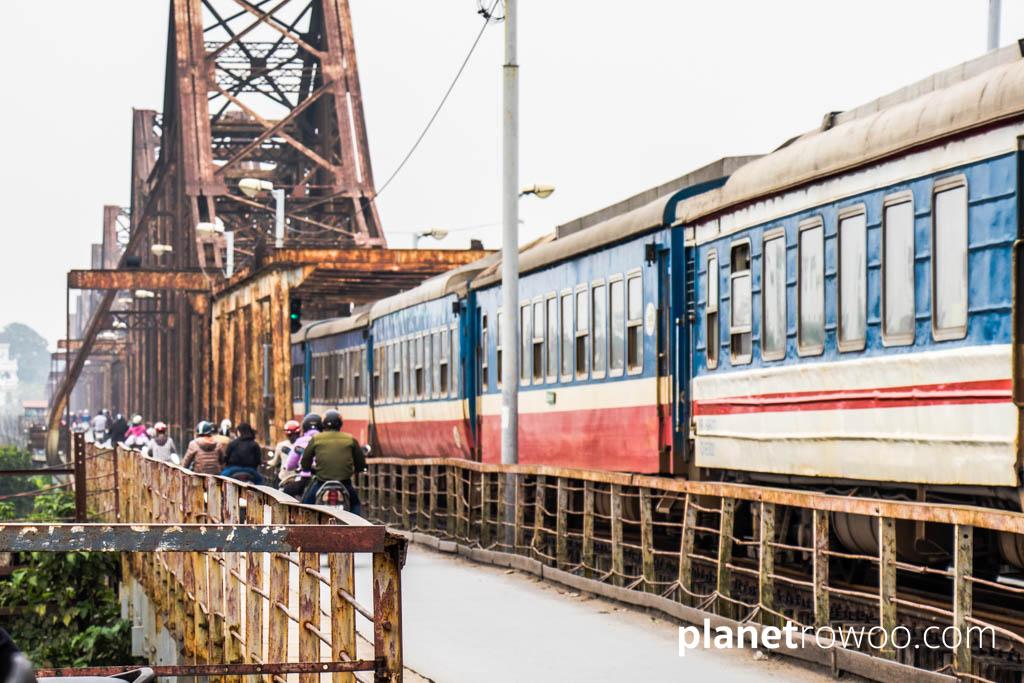
Just like Train Street in the Old Quarter, the tracks have become a favourite backdrop for Instagrammers who put themselves at risk for that perfect insta worthy image on the train tracks. A far safer option is to come in the evening as the sun goes down to capture the dramatic Red River sunset from the safety of the bridge’s sidewalk.

Access to the bridge from Banana Island is via steps or a ramp. Once on the bridge, we stopped briefly for photos. We then headed west across the bridge back towards the Old Quarter. The exit from the bridge was pretty congested… a sign that we were reemerging with Hanoi’s chaotic traffic!
Hanoi French Quarter
Heading south now on the Duong Tran Quang Khai highway which skirts the edge of the French Quarter. It’s a wide road but no less busy than the Old Quarter’s narrow lanes, with bikes and buses coming at you from all directions.
Hanoi’s French Quarter is located off the south-east edge of the popular Hoan Kiem Lake. This elegant area houses most of the city’s foreign embassies, government buildings, five-star hotels and affluent residential neighbourhoods.
Passing the picturesque, two-storey French colonial building of the National Museum of Vietnamese History we then took a brief stop by the Stock Exchange building to admire the Hanoi Opera House across the road on August Revolution Square.
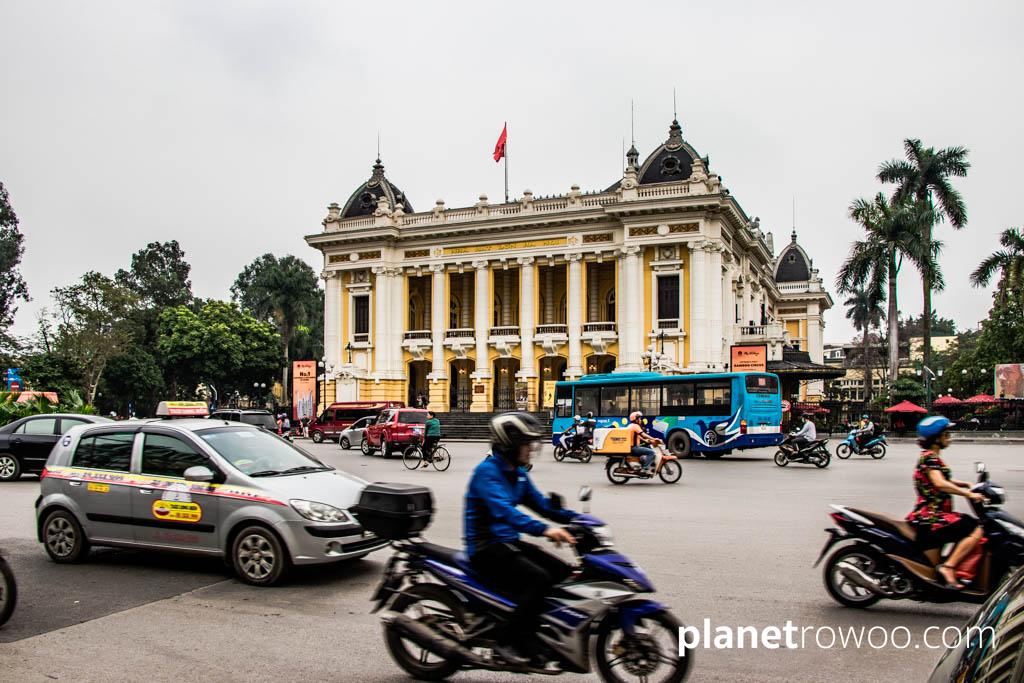
Modelled on the Opéra Palais Garnier in Paris, this historic landmark is one of the most elegant buildings in all of Hanoi. Built in 1911, it oozes Parisian charm and gothic features.
You can enjoy its grand interior by booking a weekday 90-minute tour. Or join its 600 strong audience to experience a nightly performance of events ranging from local Vietnamese opera and ballet to traditional folk music and international concerts. The schedule is available here; http://hanoioperahouse.org.vn/en.
Hanoi Old Quarter
Heading north-west now and back into the meandering back streets of the Old Quarter. Strolling on foot through the Old Quarter is one thing, but riding on the back of a scooter through the maze of alleyways is another. It was certainly one of the highlights of the bike tour for me – it’s like nothing else. Riding through dark alleys barely wide enough for two people, passing pedestrian, bike and various forms of vendor traffic is an exhilarating experience. You never know quite what you’re going to meet around the next corner.
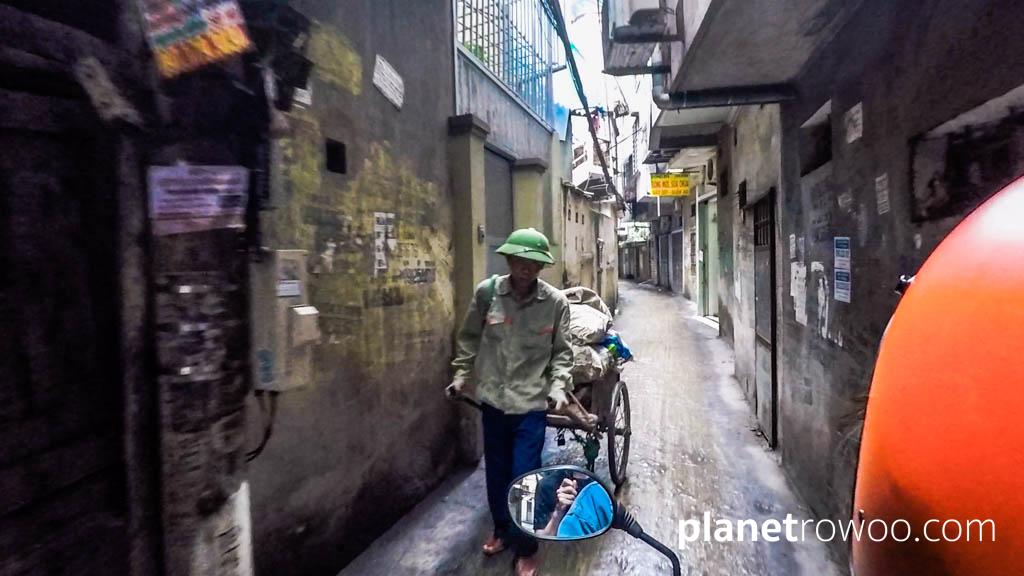
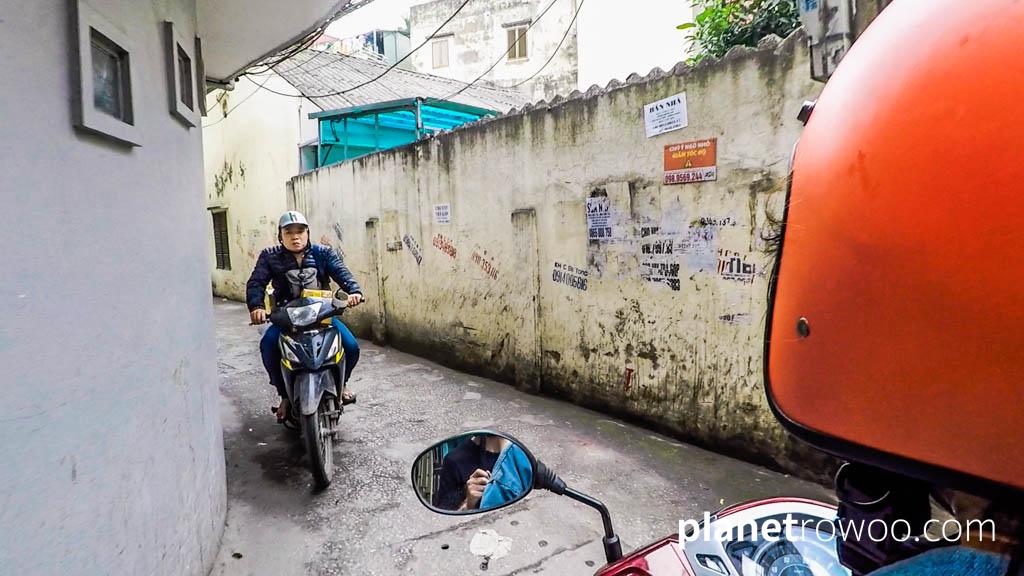
For a more detailed exploration of the Old Quarter see my Things To Do In Hanoi Old Quarter.
Ba Dinh Square / Ho Chi Minh Mausoleum
Emerging from the Old Quarter into the wide streets around Ba Dinh Square is quite a breath of fresh air. This airy wide open space is a historical landmark. It’s where Ho Chi Minh declared Vietnam’s independence from France in 1945. And where his body now lies in the Ho Chi Minh Mausoleum.
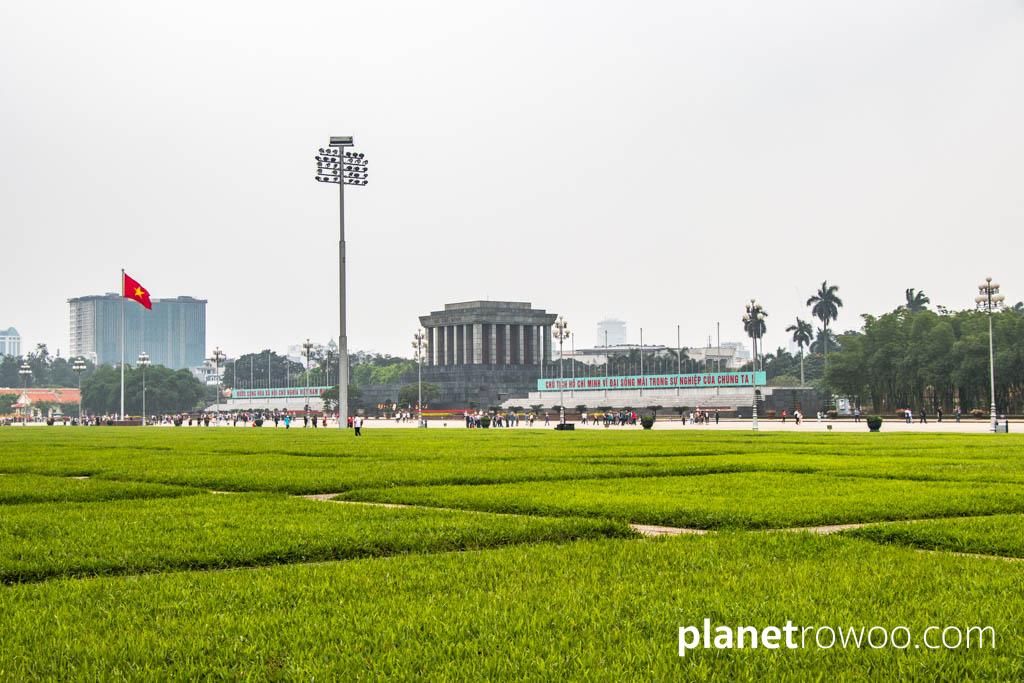
Ba Dinh Square is in the centre of the Ba Dinh Government district, with several important buildings located around it, including the Presidential Palace, the National Assembly Building, and the Ministry of Foreign Affairs.
Huu Tiep Lake, a downed B-52 Bomber & Tea with a Local
It’s just a short ride east from Ba Dinh Square to Huu Tiep Lake where the twisted wreckage of a downed US B-52 bomber lies half-submerged in the murky green waters. The bomber was shot down by the Vietnamese Air Defence Force on the night of December 27th 1972. A part of the wreckage came crashing down into the lake.
The B-52 was part of the 1972 “Christmas Bombing” campaign, known as Operation Linebacker II. Over the course of 11 days, over 700 American B-52 sorties flew over the Hanoi and Haiphong areas dropping roughly 20,000 tons of bombs and killing over 1,600 civilians.
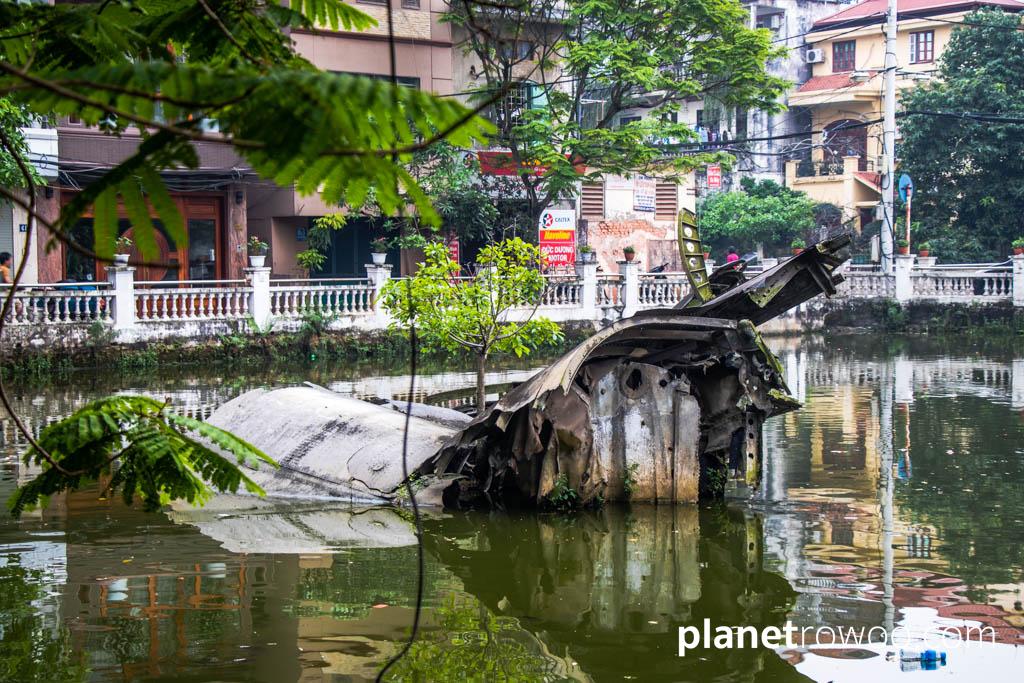
Today, the wreckage takes centre stage in the lake as a sort of war trophy of Northern Vietnam’s victory over the havoc-causing B-52s. And a symbol of triumph of the Vietnamese people.
The lake itself is set within a tranquil courtyard surrounded by traditional Vietnamese tunnel houses and french colonial style homes, and some quaint cafe’s where you can enjoy a relaxing drink or bite to eat.
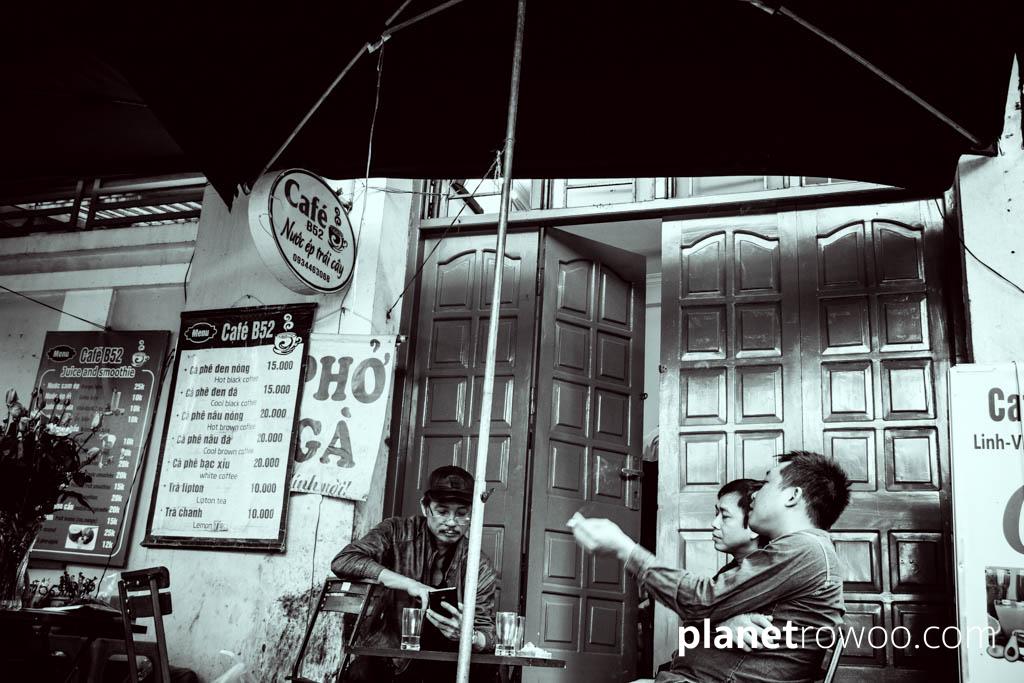
Tea with a local
From the lake, my guide led me to a tunnel house down one of the narrow alleys off the square. These tunnel (or tube) houses are so-called because of their narrow frontages and long rooms over several floors.
Inside we climbed some stairs to the first floor where we met the owner in his living room. He welcomed us in and we sat and chatted for a while, over some freshly brewed Vietnamese tea, with Lauren translating. The man explained he had lived there all his life and was a young boy when the B-52 came down in the lake. He recounted how he’d gone to the lake that night and salvaged a small piece of the wreckage which he still had today. He’d since raised a family with his wife in this same home.
It struck me that we must be of a similar age. But we’d led very different lives. He’d lived through a war throughout his childhood, surviving heavy bombings in his home town. I’ve been privileged to live in a country where peace has reigned throughout my lifetime. I’ve also been lucky enough to travel and see the world whereas this man had lived in the same place all his life. But who’s to say whose life is richer.
West Lake & The Tran Quoc Pagoda
A few minutes ride north from the tiny Huu Tiep Lake you come to the great expanse of West Lake. West Lake, or Tay Ho Lake as it’s known locally, is Hanoi’s largest freshwater lake with a shoreline extending for 17 km. It’s a popular place for Hanoians to visit as a respite from the busy city where they can enjoy its peace and natural beauty.
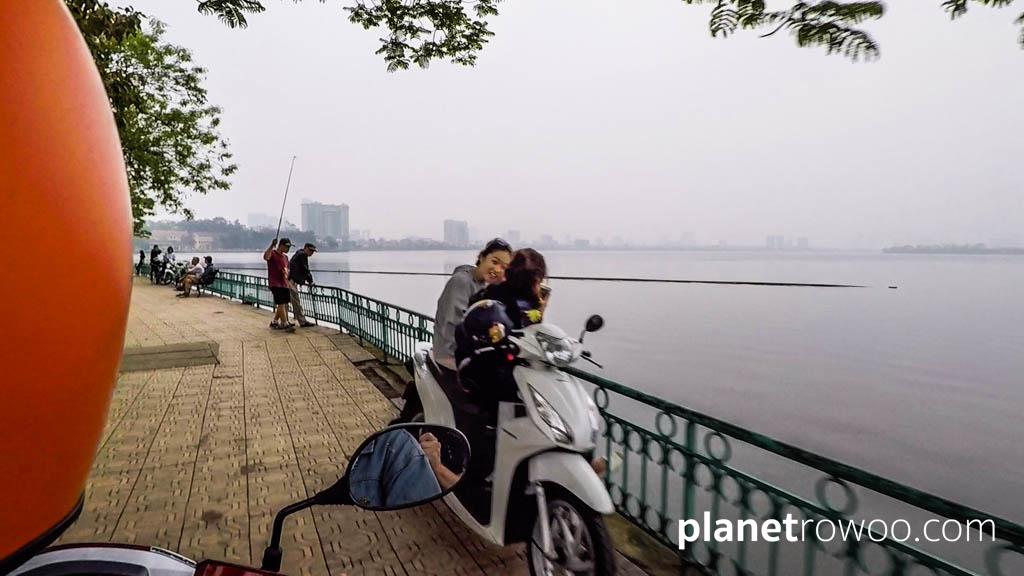
Nestled on a small island in the south-east corner of West Lake is the Tran Quoc Pagoda. It’s notable for being Vietnam’s oldest Buddhist temple, dating back to the 6th century. We took a short stop here to explore the numerous shrines and admire the main pagoda standing 15 metres high and made up of eleven levels. There’s also a museum housing historic relics.
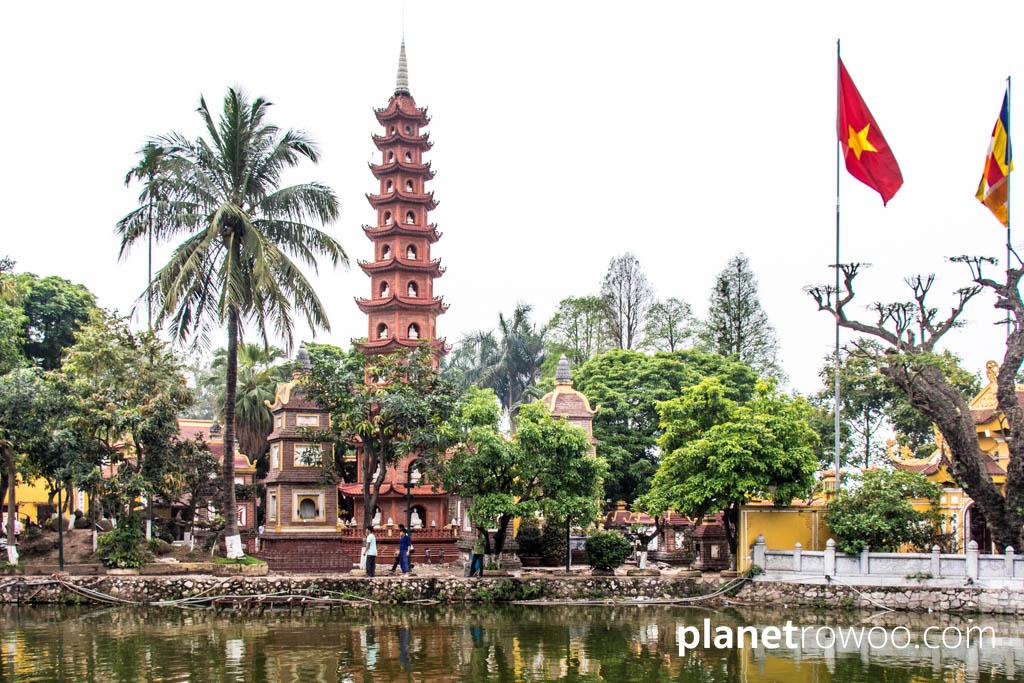
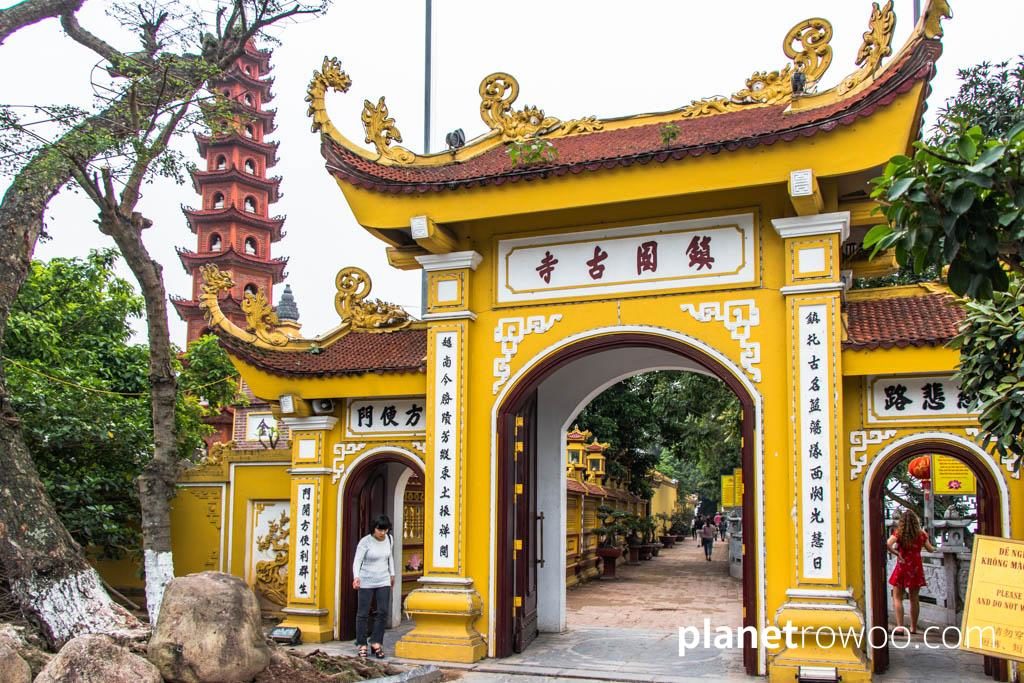
Accessible by a short causeway, the temple is open daily from 07:30am and is free to enter.
The Ride Home
Riding back now along wide leafy tree-lined avenues the city took on a Parisian feel. The roads soon narrowed again though as we hit rush hour traffic in the Old Quarter. Winding our way down through the busy Bia Hoi Junction and crossing the crazy traffic of Dong Kinh Nghia Thuc Square, we stopped briefly for a refreshing drink and final chat before returning to my hotel. It had been a great afternoon.
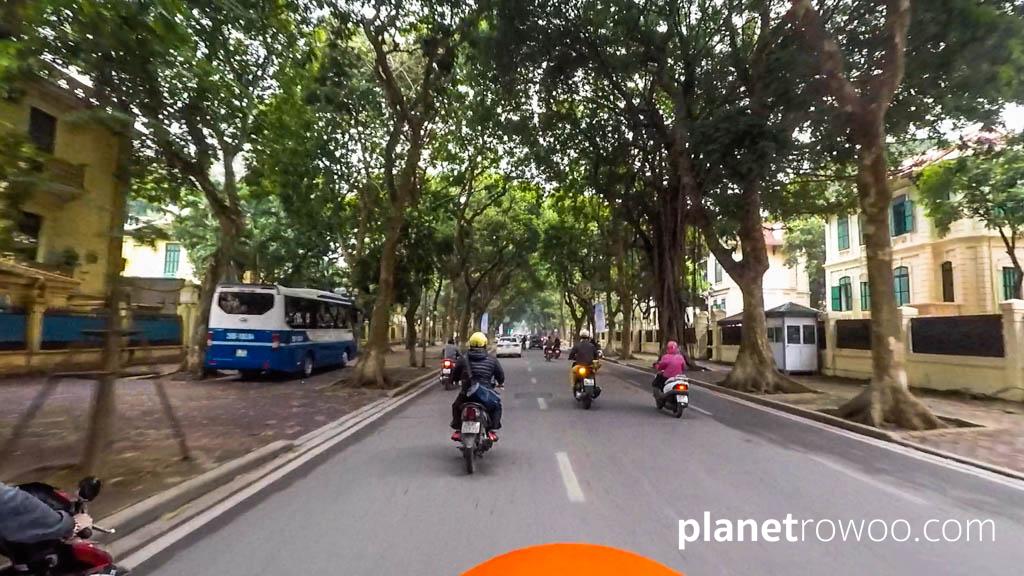
The Hanoi City Insight tour would normally include a stop at Train Street but I’d already visited there the day before and sampled the local egg coffee.
Gallery & Video
My View of Hanoi Motorbike City Tours
Hanoi Motorbike City Tours is a fantastic way to experience the sights and sounds of Hanoi in just a few hours. It’s certainly a fun and exciting way to discover some of this buzzing city’s highlights. Whizzing around the labyrinth of back streets and alleys on the back of a scooter allows you to experience the city in a way that you couldn’t if you were in a car or bus.
Lauren, my guide, was extremely knowledgeable and spoke perfect English. I felt absolutely safe as she drove me around on the back of her scooter through Hanoi’s narrow streets and alleys amid the city’s chaotic traffic. And the bikes are surprisingly comfortable!
Hanoi Smog
The only downside was that during my visit Hanoi was covered in a blanket of smog. Hence the sights and landmarks were all set against a dull grey backdrop.
Nevertheless, my Hanoi motorbike tour was still a great experience and I’d highly recommend it.
Top image: Motorbike traffic in the busy lanes of Hanoi Old Quarter
